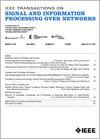Multiview Graph Learning With Consensus Graph
IF 3
3区 计算机科学
Q2 ENGINEERING, ELECTRICAL & ELECTRONIC
IEEE Transactions on Signal and Information Processing over Networks
Pub Date : 2025-01-08
DOI:10.1109/TSIPN.2025.3527888
引用次数: 0
Abstract
Graph topology inference is a significant task in many application domains. Existing approaches are mostly limited to learning a single graph assuming that the observed data is homogeneous. This is problematic because many modern datasets are heterogeneous and involve multiple related graphs, i.e., multiview graphs. Prior work in multiview graph learning ensures the similarity of learned view graphs through pairwise regularization, which has several limitations. First, most of the existing work focuses on the Gaussian Graphical Models (GGM) which learns precision matrices rather than the actual graph structures. Second, these methods do not infer the consensus structure across views, which may be useful in certain applications for summarizing the group level connectivity patterns. Finally, the number of pairwise constraints increases quadratically with the number of views. To address these issues, we propose a consensus graph-based multiview graph model, where each view is assumed to be a perturbed version of an underlying consensus graph. The proposed framework assumes that the observed graph data is smooth over the multiview graph and learns the graph Laplacians. A generalized optimization framework to jointly learn the views and the consensus graph is proposed, where different regularization functions can be incorporated into the formulation based on the structure of the underlying consensus graph and the perturbation model. Experiments with simulated data show that the proposed method has better performance than existing GGM-based methods and requires less run time than pairwise regularization-based methods. The proposed framework is also employed to infer the functional brain connectivity networks of multiple subjects from their electroencephalogram (EEG) recordings, revealing both the consensus structure and the individual variation across subjects.基于一致性图的多视图图学习
图拓扑推理是许多应用领域的重要任务。现有的方法大多局限于学习单个图,假设观察到的数据是齐次的。这是有问题的,因为许多现代数据集是异构的,并且涉及多个相关的图,即多视图图。先前在多视图图学习方面的工作是通过成对正则化来保证学习到的视图图的相似性,这有一些局限性。首先,现有的大部分工作都集中在高斯图形模型(GGM)上,它学习精度矩阵而不是实际的图结构。其次,这些方法不推断视图之间的共识结构,这在某些应用程序中可能对总结组级连接模式很有用。最后,成对约束的数量随着视图的数量呈二次增长。为了解决这些问题,我们提出了一个基于共识图的多视图图模型,其中每个视图都被假设为底层共识图的扰动版本。该框架假设观察到的图数据在多视图图上是平滑的,并学习图拉普拉斯算子。提出了一种共同学习视图和共识图的广义优化框架,该框架可以根据底层共识图的结构和扰动模型在公式中加入不同的正则化函数。仿真数据实验表明,该方法比现有的基于gmm的方法具有更好的性能,比基于成对正则化的方法所需的运行时间更短。该框架还被用于从多个受试者的脑电图(EEG)记录中推断其功能性脑连接网络,揭示了共识结构和受试者之间的个体差异。
本文章由计算机程序翻译,如有差异,请以英文原文为准。
求助全文
约1分钟内获得全文
求助全文
来源期刊

IEEE Transactions on Signal and Information Processing over Networks
Computer Science-Computer Networks and Communications
CiteScore
5.80
自引率
12.50%
发文量
56
期刊介绍:
The IEEE Transactions on Signal and Information Processing over Networks publishes high-quality papers that extend the classical notions of processing of signals defined over vector spaces (e.g. time and space) to processing of signals and information (data) defined over networks, potentially dynamically varying. In signal processing over networks, the topology of the network may define structural relationships in the data, or may constrain processing of the data. Topics include distributed algorithms for filtering, detection, estimation, adaptation and learning, model selection, data fusion, and diffusion or evolution of information over such networks, and applications of distributed signal processing.
 求助内容:
求助内容: 应助结果提醒方式:
应助结果提醒方式:


